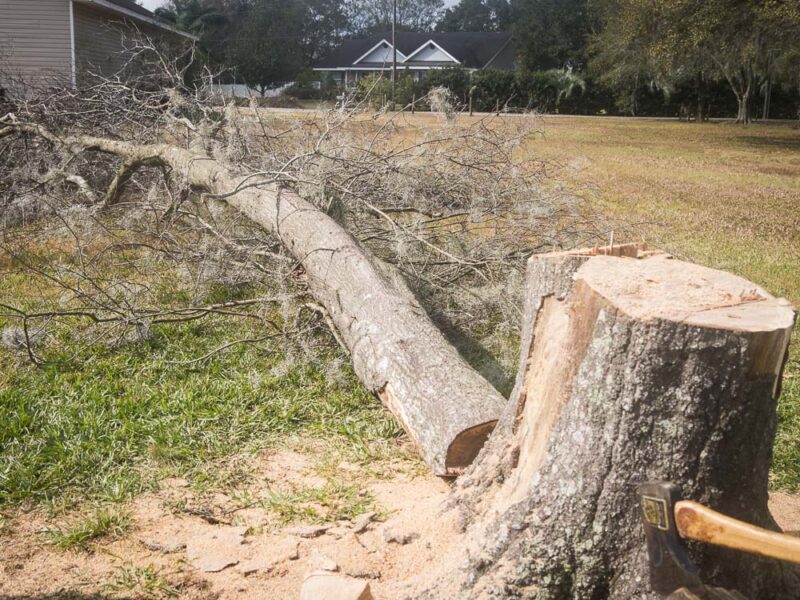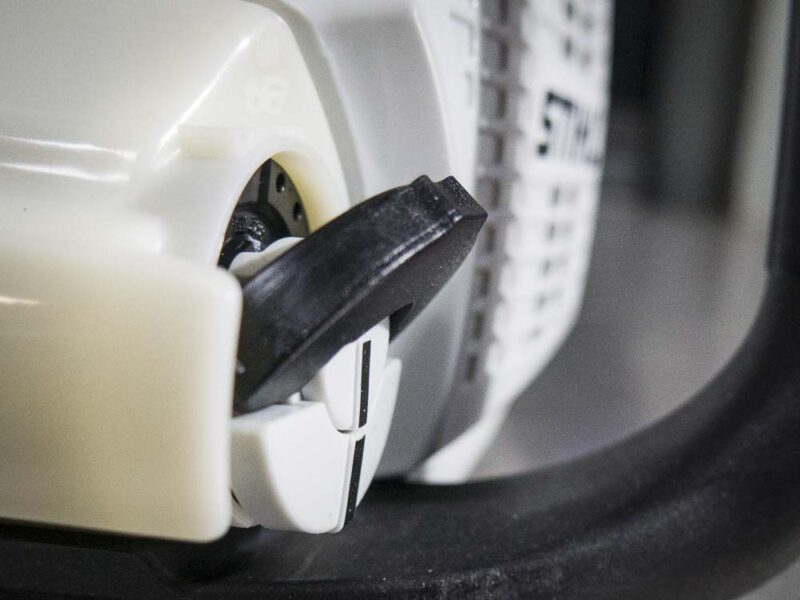Working with just about any outdoor power equipment creates safety hazards. However, chainsaws are among the most dangerous. No matter how much experience you have operating one, a simple misstep or a split-second of carelessness can result in serious injury. That said, it never hurts to run through a list of best practices, which I’ll explore in this guide to the rules of chainsaw safety.
Don’t miss our Best Pro Chainsaws and Best Battery Chainsaws lists!
Chainsaw Safety Rule #1 – Prepare
Like safe firearm handling, chainsaw safety revolves around being mindful of everything you do. Preparation is key, and it’s not that difficult. It hinges mainly on a straightforward system of checks; “no-brainers,” as I like to call them.
Stay Connected
For instance, if you’ll be working by yourself, make sure someone knows where you are. Furthermore, stay connected. Keep your phone on hand or within easy reach. Yes, it sounds like something you’d tell a classroom full of first-graders. But it’s akin to reminding someone to look both ways before crossing the street. We all get caught up in the whirlwind of daily life, and, in the process, we lose sight of the most basic safety rules, chainsaw usage included.
Ultimately, fast, effective communication is critical in the event of an emergency, and delays can be catastrophic. That’s why I strongly suggest having someone with you whenever possible. I’ve seen why first-hand.

Last year, a relative and his friend were clearing trees on our family’s farm. For a split second, he lost track of his cut. The blink of an eye was all it took for him to let his chainsaw slip. The chain made contact with his leg, and the saw’s blades did significant damage to his thigh. Thankfully, his partner was on hand to help control the bleeding and sound the alarm. Long story short, if he were alone, this story would have had a sadder ending.
At the time, he wasn’t wearing chaps, which brings me to my next chainsaw safety practice.
PPE = Chainsaw Safety
Having the right attire and safety gear is another important habit to cultivate. Never use a chainsaw in flip-flops and shorts (duh!). In addition to donning appropriate clothing, make sure you have a helmet, face shield and/or glasses, chaps, gloves, and ear protection.
Face and Head

In terms of head coverage, any helmet that provides ANSI-level protection will work. But, generally speaking, you’re best off picking up a dedicated forestry or arborist helmet.
If you work on the ground, Stihl’s Forestry Helmet (0000 886 0100) is a reliable solution. For about $90, you get the helmet, a face shield, and ear muffs. If you plan on venturing aloft with your chainsaw (a top handle, I hope!), then go with an arborist rig. They resemble rock climbing helmets, and with good reason – the idea is to offer protection, but not at the expense of the climber’s visibility and maneuverability. The Stihl Arborist Helmet (7010 883 9100) is a dependable model with a reasonable $160 price tag. Both will put you on the road to practicing the rules of chainsaw safety.
Don’t forget to shield your peepers, too! Learn everything you need to know with our guide to eye protection.
Legs
Statistically speaking, protecting your legs is one of the most important rules of chainsaw safety from a PPE perspective. My wife’s cousin would certainly agree. In a microsecond, he lost most of the mobility in his left leg and now relies on a brace to walk.
According to the U.S. Occupational Safety and Health Administration (OSHA), nearly half of all chainsaw injuries occur on the legs. This is where chaps come into play as a key component of chainsaw safety best practices.

Chaps come in two forms. Some fit over your pants on each leg. The other option is a pair of chainsaw trousers – a pair of pants with chaps built into them. The latter is the go-to for arborists, as they don’t pose the snagging hazards that come with traditional chaps.
Not-So-Fun Fact: The Centers for Disease Control (CDC) estimates that chainsaw-related injuries cost Americans $350 billion in medical expenses annually, with the average wound requiring at least 110 stitches.
Regardless of which style you choose, they both offer high-level protection against injury thanks to inner and outer layers of materials like ballistic nylon, Kevlar, polyester, and polypropylene. When blades make contact with the chaps, these layers release thousands of tiny “threads” that gum up the chain and stop it from spinning. In the world of chainsaws, it’s the analog equivalent to a SawStop table saw.
Hands
Your hands are almost as vulnerable as your legs. OSHA’s research found that 35% of all chainsaw-related injuries occur to the left hand and wrist, so wearing safety gloves is a good rule of thumb (no pun intended). Oregon’s chainsaw gloves are dependable options, as are their chaps.
When it comes to finding the right pair of kicks for your workdays, PTR has you covered. Explore our Best Work Boots Reviews list!
Chainsaw Safety Rule #2 – Know Your Equipment

Chainsaw manufacturers equip their products with a host of safety features. Make certain you know what they are and what they do.
Essentially, there are two primary mechanisms at the core of a chainsaw’s safety system: A hand guard and a chain brake. Together, they help protect the operator from the much-feared kickback. As its name implies, kickbacks occur when the chain snags, causing the bar to suddenly and without warning buck and kick back at the operator.
Kickbacks are no joke. In fact, taking them seriously could be a chainsaw safety rule in itself. Kickbacks are categorically the leading cause of chainsaw-related injuries and deaths. Unfortunately, there are a lot of them – over 35,000 each year. And, mind you, that figure doesn’t account for incidents that hospitals fail to report.
The hand guard and chain brake protect you if and when this occurs. For example, the hand guard sits between the front handle and the tool’s business end, shielding your mitts. Meanwhile, the chain brake almost instantly stops the chain if it derails or snaps.
Chainsaw Safety Rule #3 – Work Methodically
Working in a deliberate, methodical fashion is arguably the surest way to avoid accidents, especially during particularly dangerous jobs like tree felling. First and foremost, plan every step of your project. Make sure the tree falls in the proper direction, and never underestimate the potential for variations in the angle or height of the tree.
What’s more, you should check each tree for damage before cutting into it. There’s nothing more frightening than cutting into a tree only to have it unexpectedly split up the middle, potentially dropping the whole thing before you’re ready.

In short, do your best to cross and dot as many “T’s” and “I’s” as you can. Your planning should be several steps ahead of where you are on the job. So, consider all the angles.
For instance, will there be any problems removing the tree from where you plan to drop it? Similarly, does the tree lean in the opposite direction of where you want it to fall? If so, do you have a strategy in place to address this conflict, and are you ready and able to implement it?
Chainsaw Safety Rule #4 – Maintain Your Gear
If you take care of your tools, your tools will take care of you. They’ll run at peak performance, and they’ll be safer for you to operate.
For example, a dull and/or poorly-tensioned blade can pose a myriad of hazards. Check your saw before and after every job to make sure the tool is in good order. Does it have enough chain oil? Is there a maintenance schedule for the saw, and, if so, what is it?

Final Thoughts
As much as I just covered about the rules of chainsaw safety, there’s still that much more that I haven’t explored. Nonetheless, this is a solid outline of cornerstone tips and tactics. And, whether you’re a beginner or a Pro, anything you do to ensure your safety and the safety of others is a step in the right direction.



